
The upper stems terminates in narrow racemes of flowerheads about 2–8" long. Additional racemes are often produced from the axils of the upper leaves. The nodding flowerheads are about 5 mm. (slightly less than ¼") across and they have short hairy peduncles. The outer side of each flowerhead consists of 4-5 floral bracts (phyllaries) that are joined together at the base, forming a nodding cup-like shape. These floral bracts are initially green, but they later become red or brown; they have hairy exteriors. Within the cup-like shape that is formed by these bracts, there are 8-15 male (staminate) florets in the center and 3-5 female (pistillate) florets around the periphery. The male florets have tubular-funnelform corollas about 2–2.5 mm. long, while the female florets have short-tubular corollas about 1–1.5 mm. long. The male florets within each flower have stamens with yellow or white anthers, while the female florets have ovaries with white styles. The corollas of the florets are greenish white or greenish yellow. The central stalks of the racemes are similar to the upper stems, except the former is even hairier than the latter.
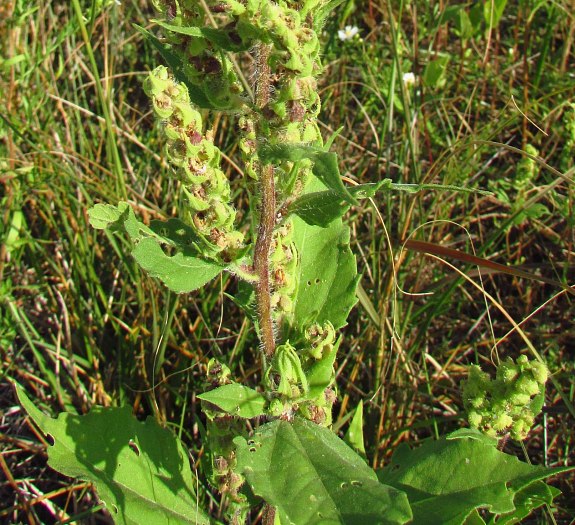
In front of the peduncles of the flowerheads, there are erect or ascending leafy bracts that are often incurved; they are 7-10 mm. in length. These leafy bracts are linear-oblong (var. caudata) to lanceolate (var. annua) in shape, medium green, and hairy, especially along their margins. Sometimes the exteriors of these bracts have central ridges. The blooming period occurs from late summer to early autumn, lasting about 3 weeks for a colony of plants. The florets are cross-pollinated by the wind. Afterwards, the corollas of the florets turn brown and wither away, and fertile pistillate florets are replaced by achenes (one achene per pistillate floret). Mature achenes are about 3 mm. long, 2 mm. across, and brown to black; they are obovoid or obpyriform in shape and slightly flattened. The achenes have no scales nor tufts of hair at their apices. The root system is a short taproot with slender fibrous rootlets. This plant reproduces by reseeding itself; sometimes it forms colonies.
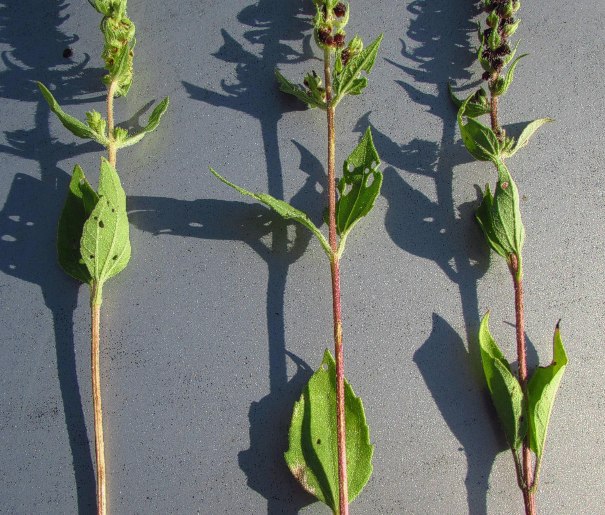
Cultivation: This plant prefers full sun and wet to mesic conditions. It tolerates a variety of soil types, including those containing sand, gravel, clay, silt, and loam, but it grows more robustly when the soil contains abundant nitrogen. Sumpweed (Iva annua) also has greater tolerance of salt (including road salt) than most plants. Most growth and development occurs during the summer and early autumn. This plant is rather weedy; it can spread aggressively by reseeding itself. The airborne pollen of the flowerheads can cause allergic reactions in some people.
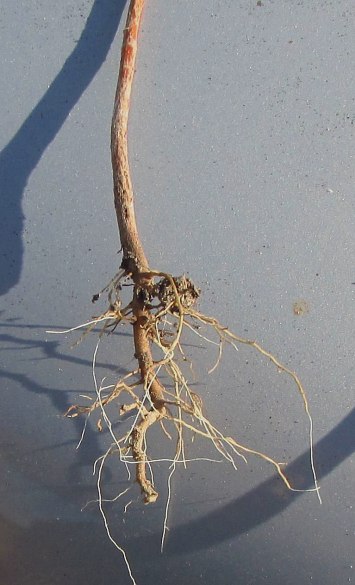
Range & Habitat: The native Sumpweed is occasional in southern and west-central Illinois, while in the rest of the state it is rare or absent (see Distribution Map). Sumpweed is widely distributed in the eastern and central regions of the United States, but it is more common in the southeastern and south-central regions than areas further to the north. Its range has expanded eastward as a result of disturbance from agriculture and other forms of modern development. Habitats include riverbottom prairies, low areas along rivers and ponds, prairie swales and sloughs, roadside ditches, cropland, fallow fields, and waste areas. Outside of Illinois, Sumpweed occurs in inland salt marshes and brackish marshes along the Gulf coast. Disturbed areas are highly preferred.
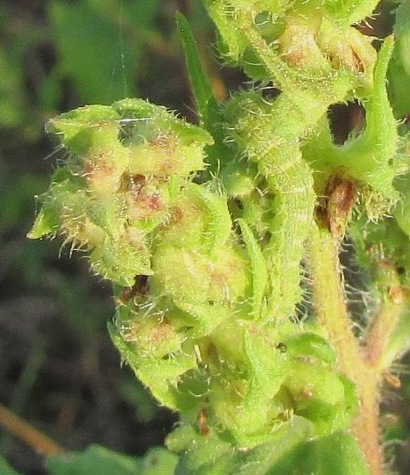
Faunal Associations: Many insects feed on the flowerheads, foliage, and other parts of Sumpweed (Iva annua). This includes the larvae and adults of a leaf beetle, Ophraella notulata, stem-boring larvae of two tumbling flower beetles, Mordellistena aspersa and Mordellistena pustulata, the Red-spotted Aster Mirid (Polymerus basalis), the Tarnished Plant Bug (Lygus lineolaris), larvae of the Iva Flower Moth (Schinia gracilenta) and Virginia Tiger Moth (Spilosoma virginica), and a seed bug, Perigenes constrictus (see Clark et al., 2004; Ford & Jackman, 1996; Snodgrass et al., 1984; Young, 1986; Natural History Museum, accessed 2010; Mitchell, 1919; and Wheeler, 2013). Cattle, White-tailed Deer, and probably other mammalian herbivores feed on the foliage of Sumpweed (Ortega et al., 1997; Self et al., 1975).
Photographic Location: A roadside in southern Illinois. The photographed plants are examples of the typical variety, Iva annua annua. The photographs were taken by Jim Doolittle (Copyright © 2017).
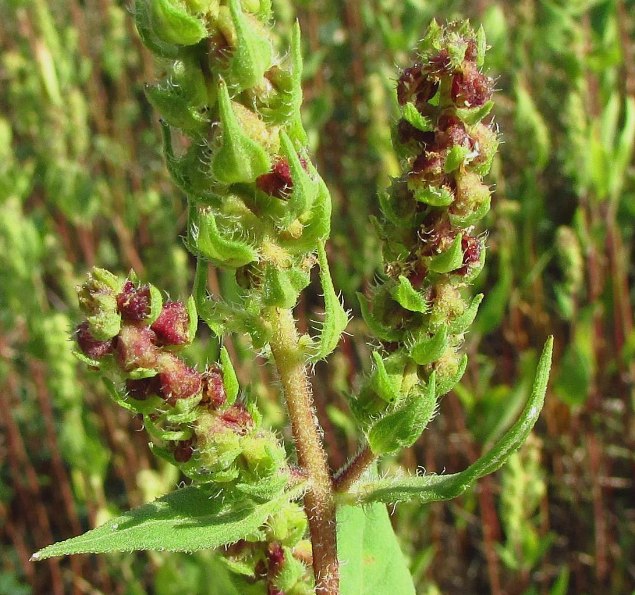
Comments: Sumpweed (Iva annua) does not have the showiest flowers because they are wind-pollinated, rather than insect-pollinated. It is in the same subfamily of plants as ragweed (Ambrosia). Sumpweed can be distinguished from similar plants in the Aster family by the large leafy bracts near its flowerheads. These bracts are much longer than the flowerheads (including their peduncles), while other similar species have either shorter leafy bracts or no leafy bracts near the flowerheads. Another distinctive trait is the camphor-like odor of the foliage. Sumpweed has an interesting archaeological history because its seeds were used by early Amerindians as a source of food prior to the arrival of the squash-bean-corn complex from Mexico. The primary region of use was the lower to middle Mississippi region and the lower Midwest along the Ohio River. A cultivated variety of Sumpweed, Iva annua macrocarpa, was used for this purpose, as its seeds were about twice as long and wide in size (about 7 mm. in length and 4.5 mm. across) as the seeds of the wild varieties of Iva annua. Unfortunately, this cultivated variety of Sumpweed is now extinct with non-viable seeds existing only at archaeological sites or inside caves (Yarnell, 1972). In Oklahoma and Texas, there is a rare parasitic vine, Cuscuta attenuata, that uses Iva annua almost exclusively as its host plant (Prather & Tyrl, 1993). Another common name of Iva annua is Marsh Elder.